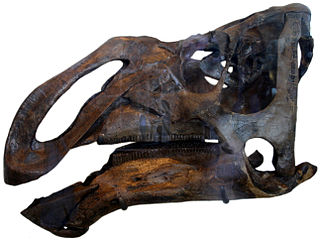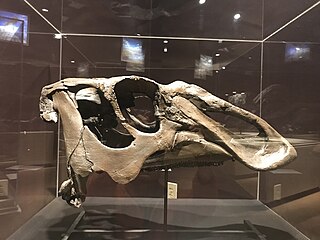
Gryposaurus was a genus of duckbilled dinosaur that lived about 80 to 75 million years ago, in the Late Cretaceous of North America. Named species of Gryposaurus are known from the Dinosaur Park Formation in Alberta, Canada, and two formations in the United States: the Lower Two Medicine Formation in Montana and the Kaiparowits Formation of Utah. A possible additional species from the Javelina Formation in Texas may extend the temporal range of the genus to 66 million years ago.

Kritosaurus is an incompletely known genus of hadrosaurid (duck-billed) dinosaur. It lived about 74.5-66 million years ago, in the Late Cretaceous of North America. The name means "separated lizard", but is often mistranslated as "noble lizard" in reference to the presumed "Roman nose".

Anasazisaurus is a genus of saurolophine hadrosaurid ("duckbill") ornithopod dinosaur that lived about 74 million years ago, in the Late Cretaceous Period. It was found in the Farmington Member of the Kirtland Formation, in the San Juan Basin of New Mexico, United States. Only a partial skull has been found to date. It was first described as a specimen of Kritosaurus by Jack Horner, and has been intertwined with Kritosaurus since its description. It is known for its short nasal crest, which stuck out above and between its eyes for a short distance.

Naashoibitosaurus is a genus of hadrosaurid dinosaur that lived about 73 million years ago, in the Late Cretaceous, and was found in the Kirtland Formation of the San Juan Basin in New Mexico, United States. Only a partial skeleton has been found to date. It was first described as a specimen of Kritosaurus by Jack Horner, and has been intertwined with Kritosaurus since its description.

The Kirtland Formation is a sedimentary geological formation.
The Twin Mountains Formation, also known as the Twin Mak Formation, is a sedimentary rock formation, within the Trinity Group, found in Texas of the United States of America. It is a terrestrial formation of Aptian age, and is notable for its dinosaur fossils. Dinosaurs from this formation include the large theropod Acrocanthosaurus, the sauropod Sauroposeidon, as well as the ornithopods Tenontosaurus and Convolosaurus. It is the lowermost unit of the lower Cretaceous, lying unconformably on Carboniferous strata. It is overlain by the Glen Rose Formation. It is the lateral equivalent of the lower part of the Antlers Formation.

The Arundel Formation, also known as the Arundel Clay, is a clay-rich sedimentary rock formation, within the Potomac Group, found in Maryland of the United States of America. It dates to the Early Cretaceous, and is of late Aptian or early Albian age. This rock unit had been economically important as a source of iron ore, but is now more notable for its dinosaur fossils. It is named for Anne Arundel County, Maryland.

The Aguja Formation is a geological formation in North America, exposed in Texas, United States and Chihuahua and Coahuila in Mexico, whose strata date back to the Late Cretaceous. Dinosaur remains are among the fossils that have been recovered from the formation. Fossil palms have also been unearthed here.
The El Picacho Formation is a geological formation in Texas, United States, whose strata date back to the Late Cretaceous. Dinosaur remains are among the fossils that have been recovered from the formation. The paleosols found here are rich in clay, calcite, and rhizoliths which show that during the Cretaceous period, this fossil formation, just like the neighboring Javelina Formation and Aguja Formation, was a fluvial flood plain.

The Almond Formation is a geological formation of Late Cretaceous age in Wyoming. It was deposited in marsh, deltaic, lagoonal, estuarine, and shallow marine environments along the western shore of the Western Interior Seaway. It consists primarily of fine- to medium-grained sandstone, siltstone, shale, and coal. Fossils from the Almond Formation include remains of dinosaurs and plants.
The Pinyon Conglomerate is a geological formation in Wyoming whose strata date back to the Late Cretaceous and Paleocene. Dinosaur remains are among the fossils that have been recovered from the formation.
The Evanston Formation is a geological formation in Wyoming whose strata date back to the Late Cretaceous. Dinosaur remains are among the fossils that have been recovered from the formation. The fossil formation also has the remains of prehistoric mammals from the Paleocene epoch.
La Bocana Roja Formation is a geological formation in Baja California, Mexico whose strata date back to the Late Cretaceous, althought the precise age is unclear. Dinosaur remains are among the fossils that have been recovered from the formation.

The Cerro del Pueblo Formation is a geological formation in Coahuila, Mexico, whose strata date back to the latest Campanian of the Late Cretaceous, just before the Campanian-Maastrichtian boundary. Dinosaur remains are among the fossils that have been recovered from the formation. The formation is believed to correlate with the Baculites reesidesi and Baculites jenseni ammonite zones, which dates it to 73.63-72.74 Ma.
The Zhumabao Formation is a geological formation in Shanxi, China whose strata date back to the Late Cretaceous. Dinosaur remains are among the fossils that have been recovered from the formation.

The Ripley Formation is a geological formation in North America found in the U.S. states of Alabama, Georgia, Mississippi, Missouri, and Tennessee. The lithology is consistent throughout the layer. It consists mainly of glauconitic sandstone. It was formed by sediments deposited during the Maastrichtian stage of the Late Cretaceous. It is a unit of the Selma Group and consists of the Cusseta Sand Member, McNairy Sand Member and an unnamed lower member. It has not been extensively studied by vertebrate paleontologists, due to a lack of accessible exposures. However, fossils have been unearthed including crocodile, hadrosaur, nodosaur, tyrannosaur, ornithomimid, dromaeosaur, and mosasaur remains have been recovered from the Ripley Formation.
The Hornitos Formation is a Campanian geologic formation of the Algarrobal Basin in the Atacama Region of northern Chile. The formation comprises limestones, sandstones, conglomerates, marls and tuff. Dinosaur remains are among the fossils that have been recovered from the formation, including the sauropod Arackar licanantay.

The Ojinaga Formation is a Mesozoic geologic formation. Dinosaur remains are among the fossils that have been recovered from the formation, although none have yet been referred to a specific genus.
The Packard Formation is a Mesozoic geologic formation. The formation may be from the Kirtlandian land vertebrate age. It has a similar fauna to the Corral de Enmedio Formation.
The Piedrahita de Muñó Formation is an Early Cretaceous geologic formation of the Cameros Basin in northern Spain. Fossil theropod tracks have been reported from the formation. Also fossils of Lepidotes sp., Polacanthus sp. and Testudines indet. were found in the formation.











